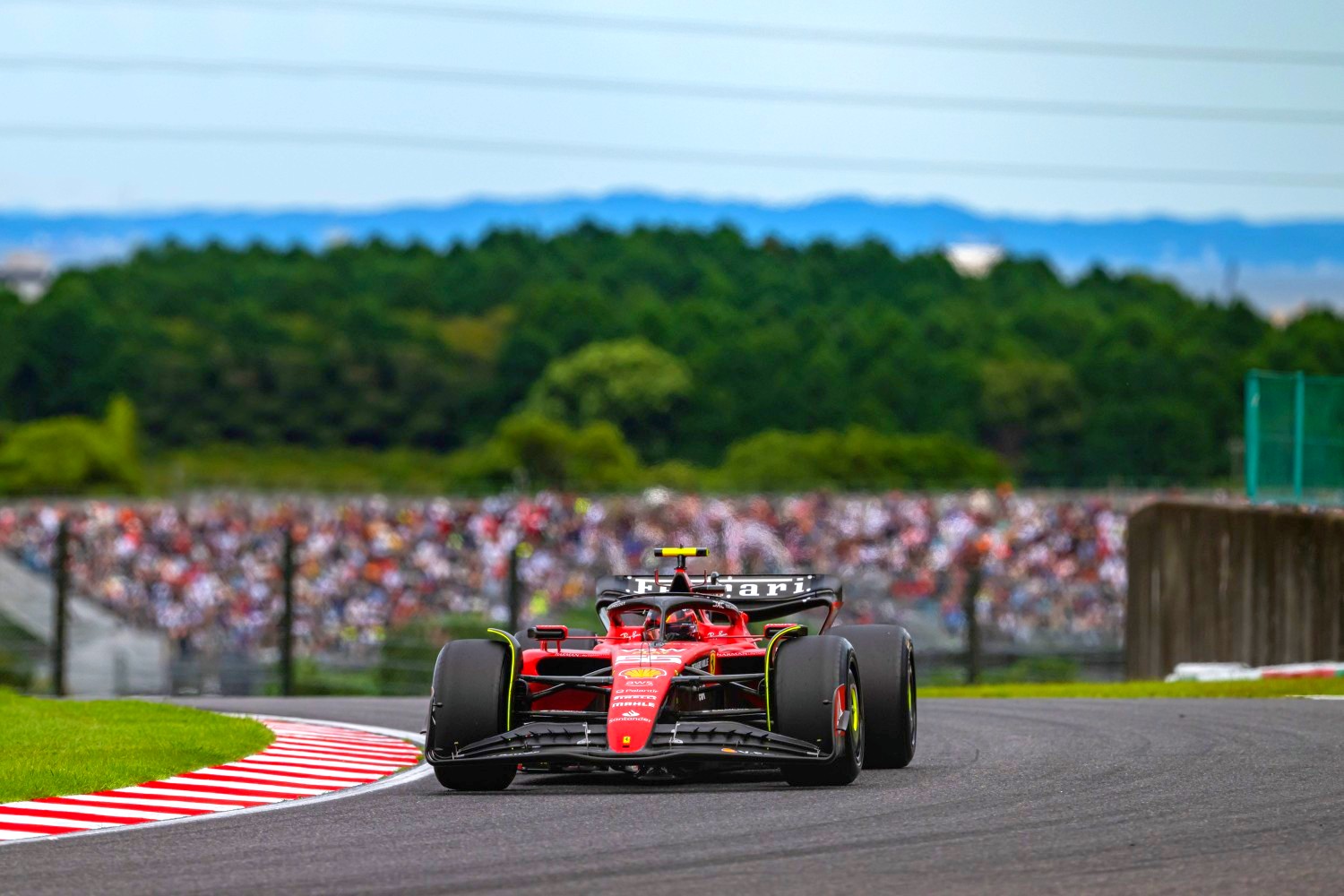Formula 1 News: 2024 Japanese GP at Suzuka Preview
We preview this weekend’s Japanese GP Formula 1 race at the historic 3.61-mile long Suzuka circuit, owned by Honda.
Formula 1 returns to Japan just over six months after its last visit to the country. This year, the Japanese Grand Prix takes place in April for the first time in its history: right up to last year the race was always scheduled for the second part of the season, in September or October
The fourth event of the season coincides with the peak of the cherry blossom – or Sakura – season, between the end of March and beginning of April. It’s also the very first time that the Japanese Grand Prix will be held at this time of year: the first Pacific Grand Prix took place at Aida on 17 April 1994, before moving to October in 1995. The early spring will also bring lower temperatures than the teams are used to in Japan, with average temperatures ranging between 8°C and 13°C.

Japan initially joined Formula 1’s schedule at Fuji Speedway in 1976, a race made famous for the title showdown between James Hunt and Niki Lauda, but after its second year the country was absent for a decade. When Formula 1 eventually returned to Japan, in 1987, it did so at the demanding figure-of-eight Suzuka Circuit.
Its placement in the calendar means Suzuka has been the scene for the crowing of several world champions, some after high-profile collisions, while Max Verstappen became the latest world champion to secure a title at Suzuka, in 2022. It will be the last Suzuka race to take place in the fall for some time with the event due to shift to spring from 2024.
Speak to any Formula 1 driver, and they will immediately place Suzuka among their favorite racetracks. The drivers cascade into the high-speed right-hander at turn 1 before plunging immediately into a sequence of Esses, undulating through the scenery with rapid changes of direction. Fast corners such as Degner 1 and Degner 2, Spoon Curve and 130R require inch-perfect precision, while more technical turns including the hairpin and chicane are also deceptively tricky. The close proximity of grass, gravel and unforgiving barriers means even minor errors can be heavily punished.
Torrential rain and typhoons can even interrupt proceedings at Suzuka. On three occasions (2004, 2010, 2019) qualifying was moved to Sunday morning following the threat of a typhoon, while in 2022 the race was shortened with only 28 of 53 scheduled laps completed due to persistent heavy rainfall.

With an average speed of 153mph (240km/h), Suzuka is one of the quickest tracks on the F1 calendar.
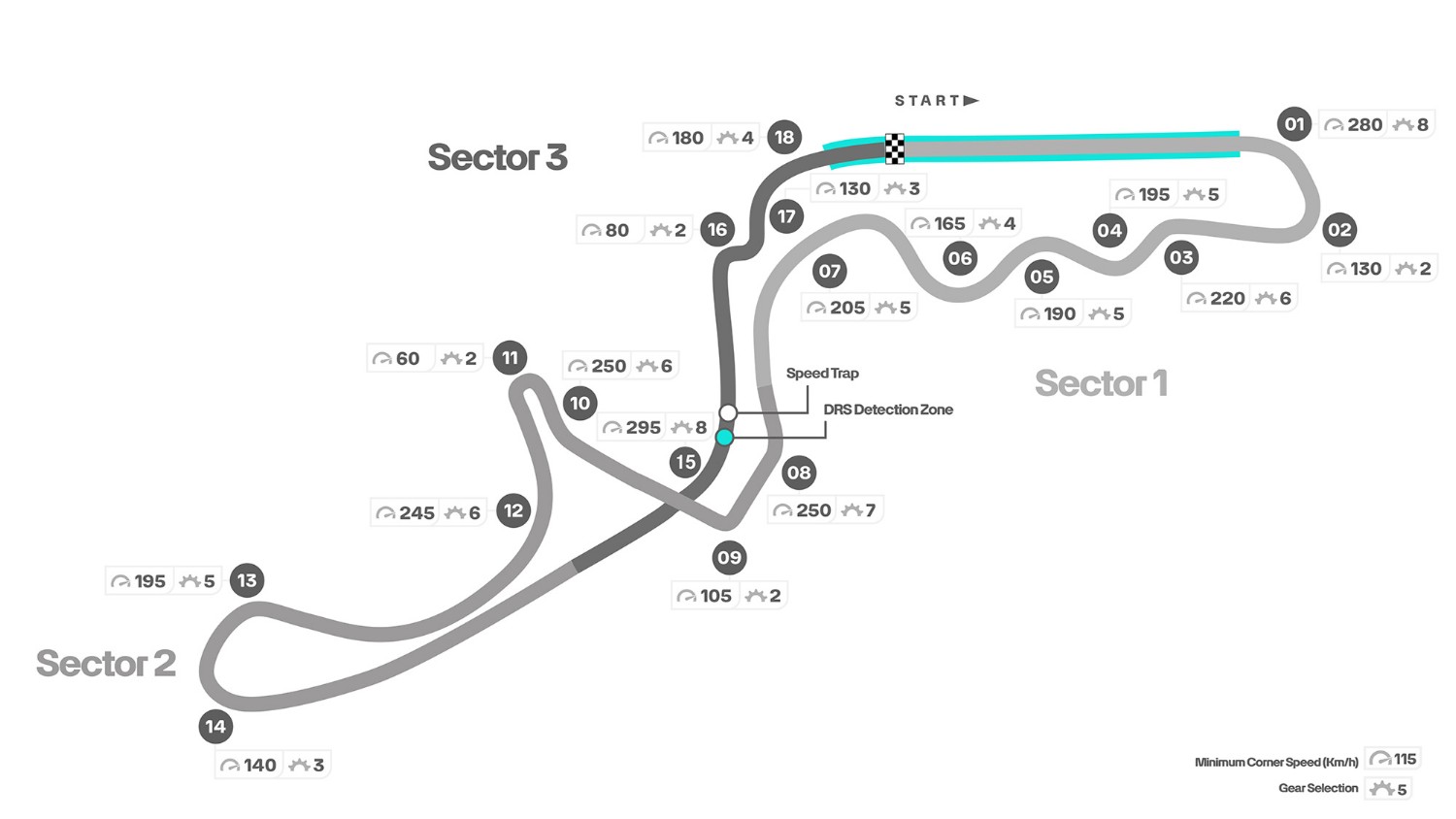
Suzuka is revered throughout the world as one of motorsport’s finest permanent circuits, with drivers barely having time to breathe through the lap, as they walk a tightrope while pushing their machines to the limit. The first sector is dominated by the Esses, a sequence of narrow sweeping medium- and high-speed corners that rise and plummet, while corners such as Spoon and 130R require total commitment.

The peril is enhanced by the proximity of the grass, gravel traps and barriers, meaning mistakes are regularly punished. Suzuka is also the only circuit on the calendar to feature a flyover, with drivers passing underneath the entry to 130R as they negotiate the exit of Degner 2.
Overtaking is not easy in Suzuka but it is possible and the racing is always good here. The drivers will need to quickly find a rhythm, especially through the Esses, but once they have that, the lap time can improve very quickly.
A little history…..
The Suzuka circuit has 18 corners, some of which – such as Spoon, 130R and the uphill combination between Turns 2 and 7 – are among the most famous on the world championship calendar. Less well-known are the two Degner corners, named after Ernest Degner, a German motorcycle racer of the 1950s and 1960s.
Born in Gleiwitz (in Poland’s Silesian Highlands) in 1931 and raised in East Germany, Degner was one of the most prominent sportsmen in Eastern Europe. He raced MZ two-stroke motorcycles designed by Walter Kaaden: a brilliant engineer who worked for the Nazis at Peenemunde during World War II: the secret weapons research facility commissioned by Adolf Hitler. Thanks to Kaaden’s creativity, the MZs were able to beat not only the established European competition but also those of their emerging rivals from Japan, who were just beginning to make their name.
In 1960, for example, Suzuki entered international competition for the first time but the Japanese bike was dramatically slow, finishing the 1960 Isle of Man TT a full 15 minutes behind the winner. It was clear that the Japanese firm urgently needed external know-how, but where to find it? The answer came in the form of a chance meeting that took place the following year between Degner and company president Shunzo Suzuki. During their conversation, Degner said he was tired of his dull life in East Germany, as the rest of the world was starting to emerge from post-war austerity: he had also had enough of the constant surveillance from the Stasi – Germany’s secret police – who followed him to every race.
The Stasi were so concerned that Degner might defect that his family weren’t allowed to come to race, so that he would always have a reason to come home. Naturally, Degner also hated the fact that most other riders – even those with far less talent – were paid much more than him, as under his home regime he had to settle for a salary equal to virtually any other MZ worker.
An agreement was quickly reached: Degner would run away, help Suzuki develop their bikes and then race for the Japanese. But he wouldn’t leave East Germany without his family and, with the Berlin Wall having just gone up, getting them out seemed almost impossible.
So during the 1961 Swedish Grand Prix weekend (which took place in Kristianstad) Degner organized his family’s escape, with the help of a friend from West Germany who made frequent business trips to East Berlin. The friend smuggled them out in a secret compartment in the boot of a Lincoln Mercury, with Degner relying on the fact that the Stasi spent more time watching him at race weekends abroad than his family at home.
He retired from the Swedish race due to engine failure and then fled to West Germany to reunite with his family before moving to Hamamatsu, where Suzuki’s headquarters were located. MZ immediately cancelled their overseas race program, just in case anyone else had the bright idea of following Degner’s example…
Degner raced for Suzuki in 1962; despite living in constant fear of being killed by the Stasi, he still managed to win the first world title in the 50cc class. But the dream turned into a nightmare the following year. At the Japanese Grand Prix in Suzuka he fell from his bike in the place now known as the Degner Curves and, when the fuel tank exploded, he suffered severe burns requiring over 50 skin grafts.
He returned to racing the following year but was dogged by other accidents before retiring for good in 1966. Living with constant pain caused him to slip into morphine addiction: his death in 1983 aged just 51 (when he was living in Tenerife) was officially down to a heart attack, but many thought it was caused by an overdose, while some people believed that the Stasi finally caught up with him.
In any case, Turns 8 and 9 of the Suzuka track are now named after him as a tribute to his contribution to Japanese motorcycling history.
Max Verstappen’s View
“Suzuka is always a great circuit to go racing at. As a Team, we have had a lot of special memories here over the years including winning last year’s Constructors’ Championship as well as winning my second Drivers’ Championship here too.
“It has been nice to have had a break with family and friends before the racing starts and always fun to be able to spend some time in Tokyo too.
“The last race in Melbourne was unfortunate and these things happen, however we achieved nine race wins in a row, which is an impressive feat, so we are looking to come back even stronger for this weekend.
“The Team is feeling confident for Suzuka: it is an iconic circuit and is always fun to drive. The track has a lot of high speed corners and high degradation and we need to ensure that we optimize our performance where we can, especially with rain forecasted for this weekend.
“I am looking forward to getting back in the car and ready to fight for the win this weekend.”

Last Year’s 2023 Japanese GP
World Champion Max Verstappen cruised to a dominant win in the 2023 Japanese GP and scored enough points to give Red Bull the Constructors title.
With 101,000 sun drenched fans looking on, Verstappen took the lead from the pole at the start after a short tussle with Lando Norris who got a better jump from third place.
Verstappen got ahead by Turn 2 and thereafter only lost the lead for a couple of laps during pit stops to beat the McLarens of Lando Norris and Oscar Piastri by almost 20 seconds at Suzuka.
It was Verstappen’s 48th career F1 win and Red Bull’s 6th Constructor’s title. That’s the second straight constructors’ title for the Bulls, and a 13th win of the year for the Dutchman.
Verstappen took the 1 point for fastest lap as well. Verstappen’s fastest lap was 1.064s quicker than any other driver.
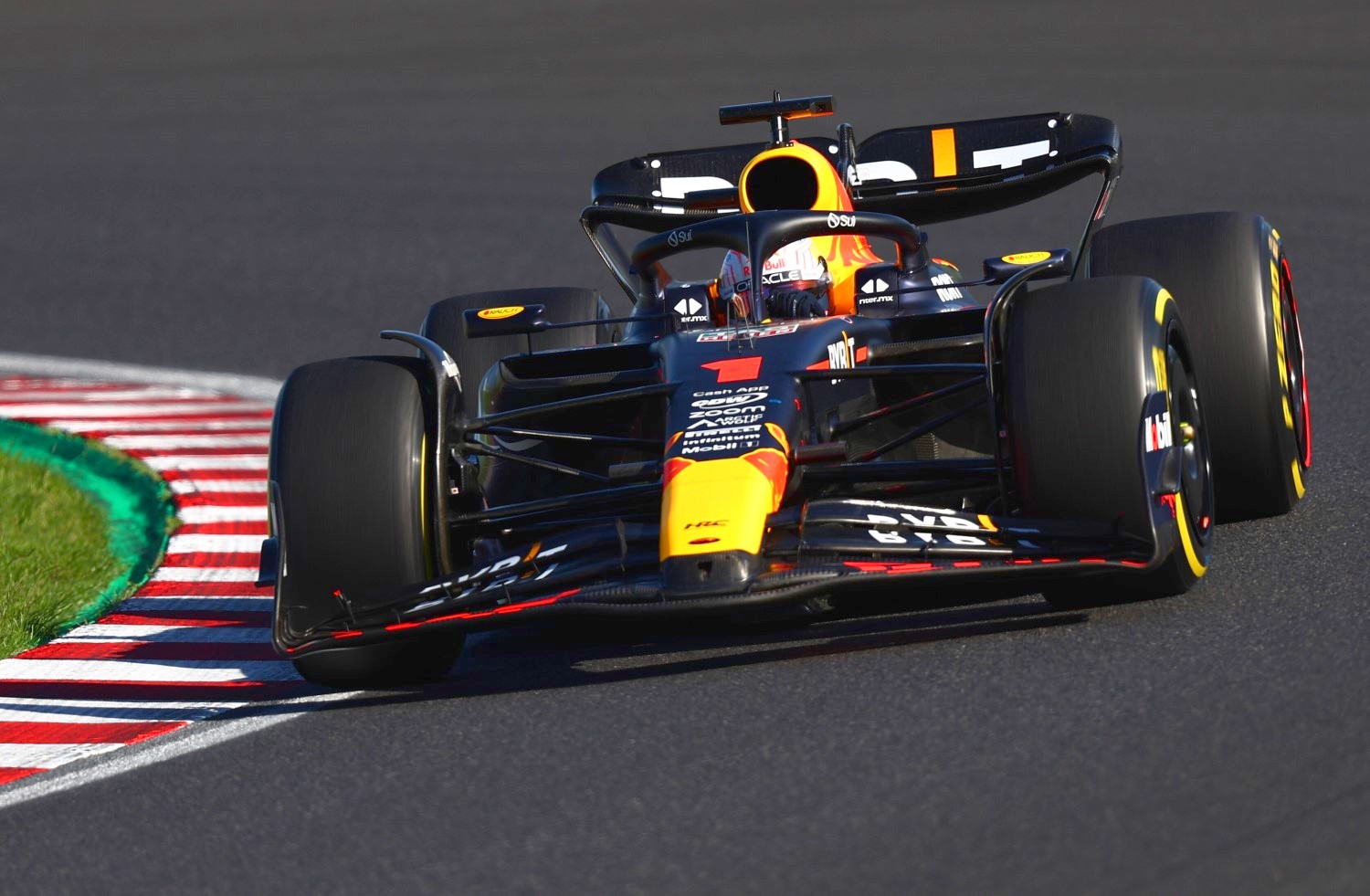
Unlocking the Lap
Revered by all drivers and one of the most spectacular places to watch a Formula One car on the limit, the opening snake through the Esses is as challenging as it is rewarding. The corners flow into each other, so learning and perfecting these entries and exits is critical to a quick time through the first sector.

There is little rest after the Esses; the Degner section of the circuit – two very tricky right-handers – follows immediately. The first turn is fast but has a very tight exit and it is easy to run wide. The second corner arrives almost straight away – it is slightly banked, but running wide is also commonplace and can ruin a quick-lap.
The left-handed double-apex Spoon Curve precedes the longest flat-out section on the circuit and is crucial to lap-time. The first part is very fast but drivers need to resist the urge to push too soon and run out of road before the second apex. The bend leads onto a long blast up to 130R and is easy to misjudge, being slightly off-camber.
Fact File: Japanese Grand Prix
- Suzuka holds the distinction of being the only circuit we race at that is laid out in a figure-of-eight configuration.
- After the Degner Curves, the circuit passes under the straight leading to 130R. Owing to this, it’s the only F1 track that runs both clockwise and anticlockwise.
- This figure-of-eight layout is beneficial for tire wear. It creates a more even balance between left and right-hand corners (10 being right-handers and eight to the left), distributing load more equally between tires.
- The first corner doesn’t require any braking on entry. In Qualifying, drivers don’t hit the brakes until the car is cornering at close to 5G.
- That helps to generate some of the highest steering wheel torques of the entire season.
- The vast majority of the first sector at Suzuka is spent cornering. From Turn 1 until the exit of Turn 7, the steering wheel is moving almost continuously for nearly 2km of the lap.
- Just 1.2 km of the lap is spent driving in a straight line. Most of the 5.807 kms sees some lateral g-force going through the car.
- The lack of straights also means that Suzuka is just one of four circuits on the calendar that has a solitary DRS zone.
- 130R is one of F1’s quickest corners, taken at 295 km/h. Turn 11, meanwhile, is one of the slowest at 60 km/h.
- The braking zone for Turn 11 is particularly challenging. Drivers must hit the brakes midway through the fast Turn 10. They are cornering at close to 3.5G while turning right before the hairpin left. Lockups are therefore common.
- In contrast to Singapore, brakes have a slightly easier time at Suzuka. There are only two heavy braking events on the track. Brake duty and wear are therefore among the lowest we see across the year.
- Suzuka has one of the highest mass sensitivities of the season. That means that carrying more fuel is more penalizing in terms of lap time and performance.
Weather Forecast (Very Changeable weather)
Friday
Clear in the morning but clouds moving in after lunch and possible rain. High 64F. Winds light and variable. Chance of rain 90%.
Saturday
Mostly Cloudy skies. High 68F. Winds light and variable.
Sunday
Periods of Rain. 60% chance of Precipitation. High 68F
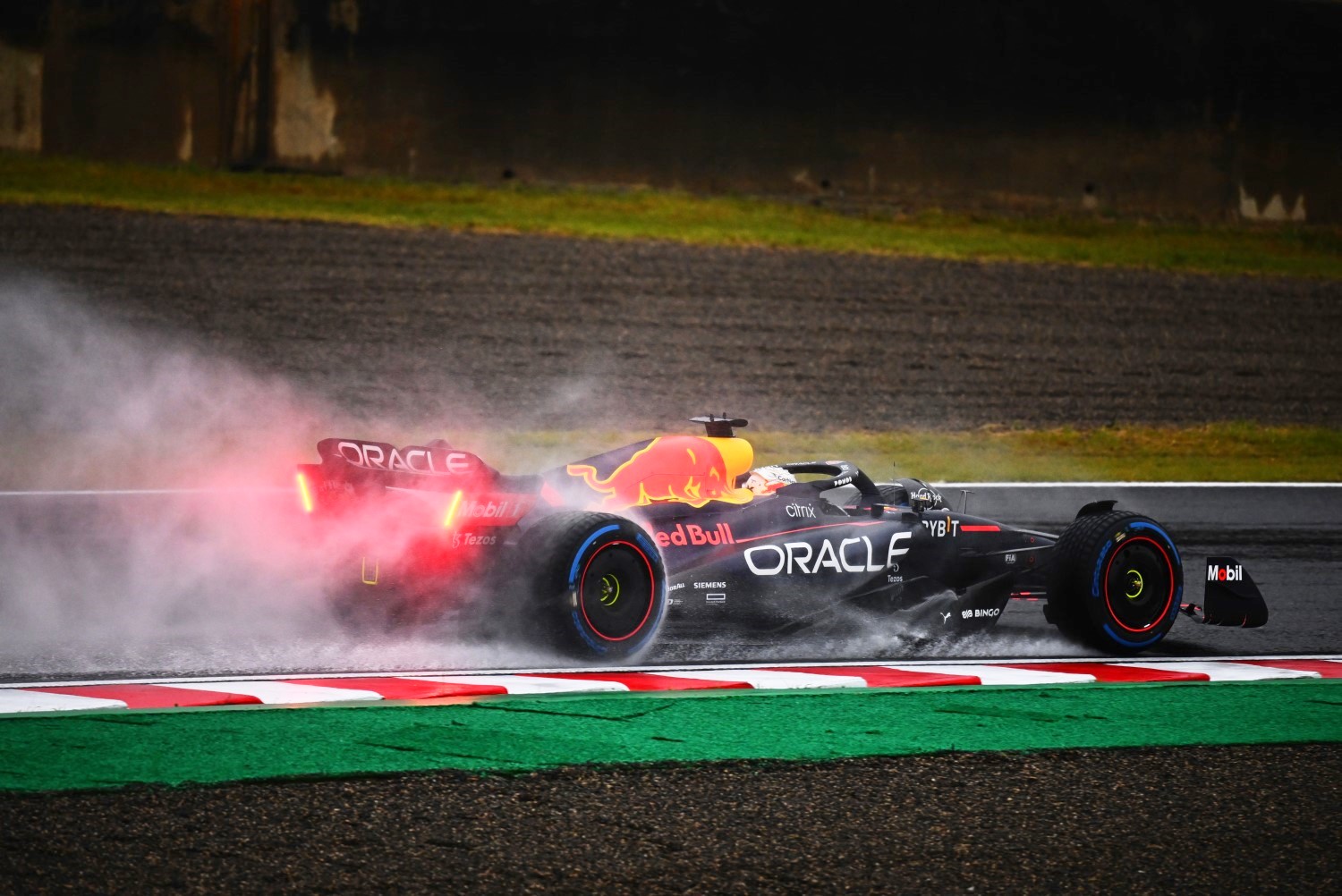
Which drivers have won the Japanese Grand Prix?
There have been 18 different winners of the Japanese Grand Prix since 1987 with Michael Schumacher being the most successful of them. Mario Andretti won the inaugural race hosted in 1976 at the Fuji circuit, while Gerhard Berger was the first victor at Suzuka.
Of the drivers currently on the gird, four have won there, including Hamilton, Valtteri Bottas, Max Verstappen and Fernando Alonso.
Hamilton (five), Verstappen (two) and Alonso (two) have all won multiple times there.
The last 11 winners of the Japanese Grand Prix:
2010 – Sebastian Vettel
2011 – Jenson Button
2012 – Sebastian Vettel
2013 – Sebastian Vettel
2014 – Lewis Hamilton
2015 – Lewis Hamilton
2016 – Nico Rosberg
2017 – Lewis Hamilton
2018 – Lewis Hamilton
2019 – Valtteri Bottas
2020 – Cancelled – Covid
2021 – Cancelled – Covid
2022 – Max Verstappen
2023 – Max Verstappen
Pirelli Tires
In addition to representing an extraordinary challenge for cars and drivers, the track also tests the tires: both in terms of wear – due to high levels of asphalt roughness and abrasiveness – as well as through the forces and loads to which they are subjected throughout the variety of corners that make up the lap. As usual, Pirelli has selected the hardest trio of compounds: C1 as hard, C2 as medium and C3 as soft. This is the same selection as was used in Bahrain for the first race of the season.
A two-stopper is the most common strategy, due to the energy going through the tires and the stress to which they are subjected. However, lower temperatures might mean that a one-stop strategy becomes possible, especially for drivers who are gentle on their tires. On the other hand, this might make it harder to keep the tires in the correct operating window, particularly when bringing them up to temperature on an out-lap from the pits. A one-stopper also decreases the effectiveness of the undercut, which is usually very useful at Suzuka, even with the hard and medium compounds being the preferred race compounds.
After the Japanese Grand Prix there will be two days of Pirelli tire testing on Tuesday 9 April and Wednesday 10 April with Stake F1 Team Kick Sauber and Visa Cash App RB Formula One Team, to develop constructions and compounds for next season..
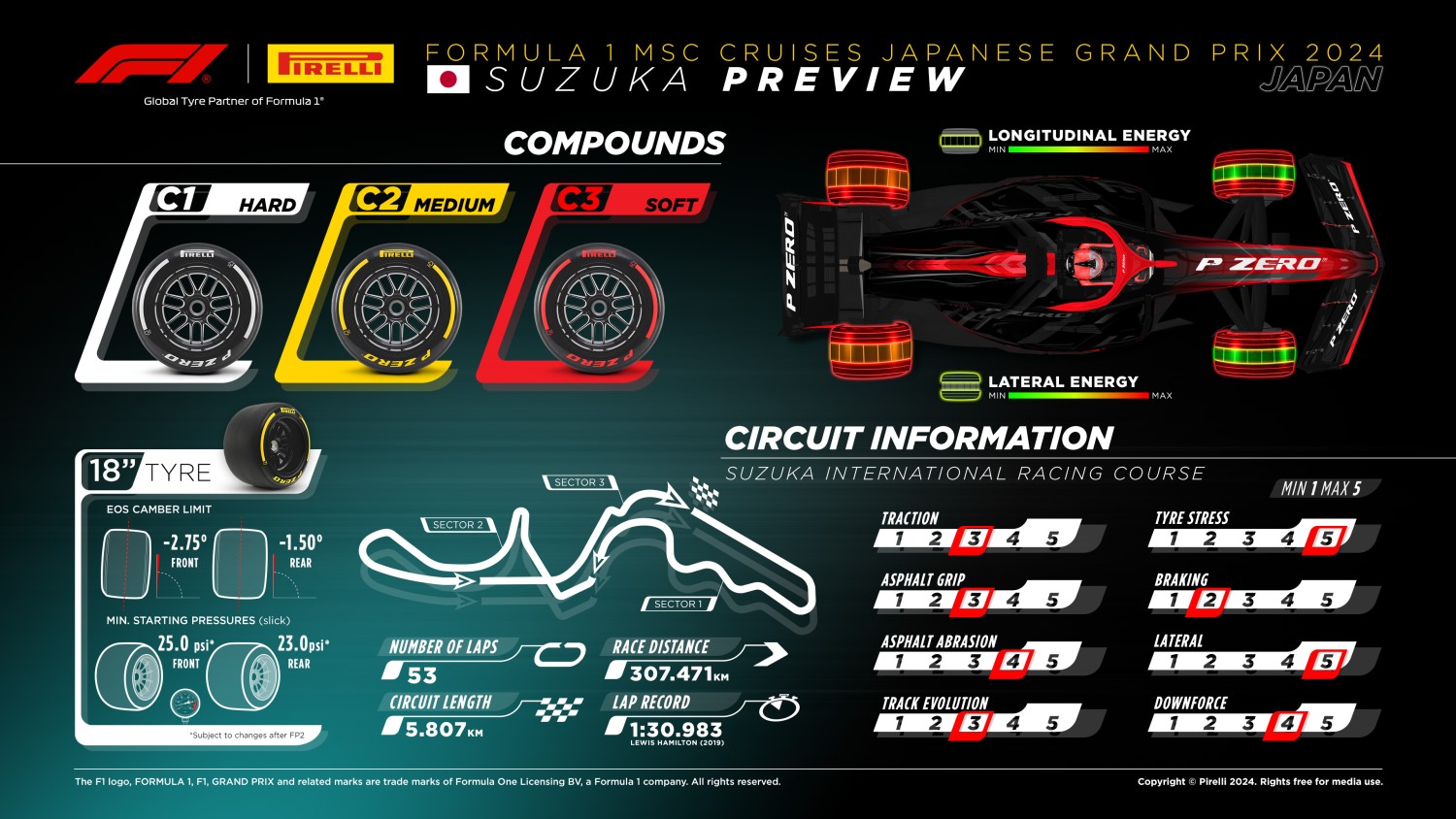
MARIO ISOLA – MOTORSPORT DIRECTOR
“The Japanese Grand Prix takes place on one of the most fascinating and demanding tracks in Formula 1 history: Suzuka, with its unique figure of eight layout.
“This historic venue is a drivers’ favorite, being absolutely thrilling to drive in today’s ultra-competitive single-seaters.
“With its very significant lateral and vertical loads, Suzuka is as demanding on tires as it is on drivers.
“These demands are equally distributed across all four wheels, with 10 right-handers and eight left-handers throughout the six-kilometer lap.
“As a result of these challenging characteristics, we bring some of the hardest tires in the 2023 range to Japan: C1, C2, and C3 – the same as last year.”
